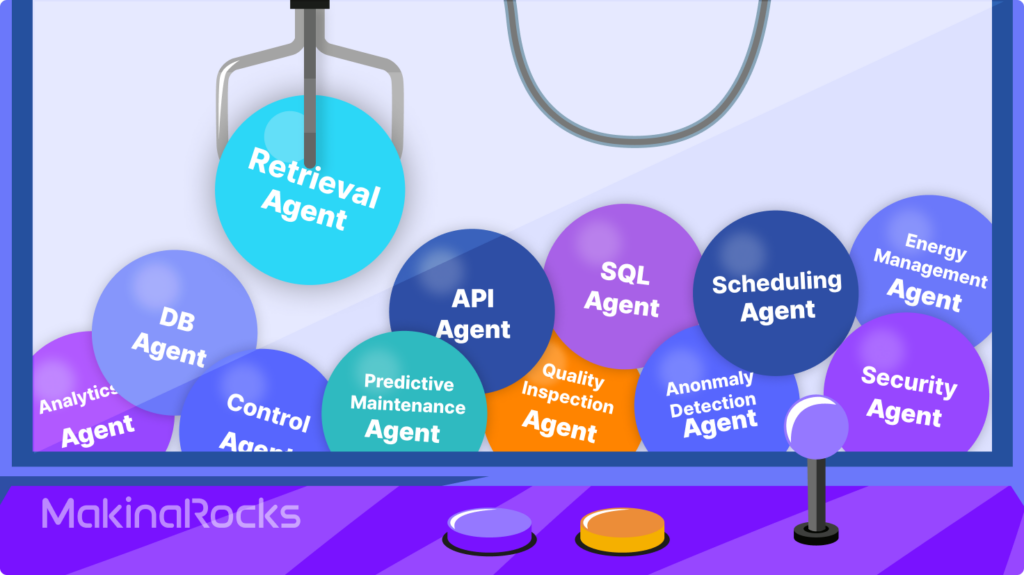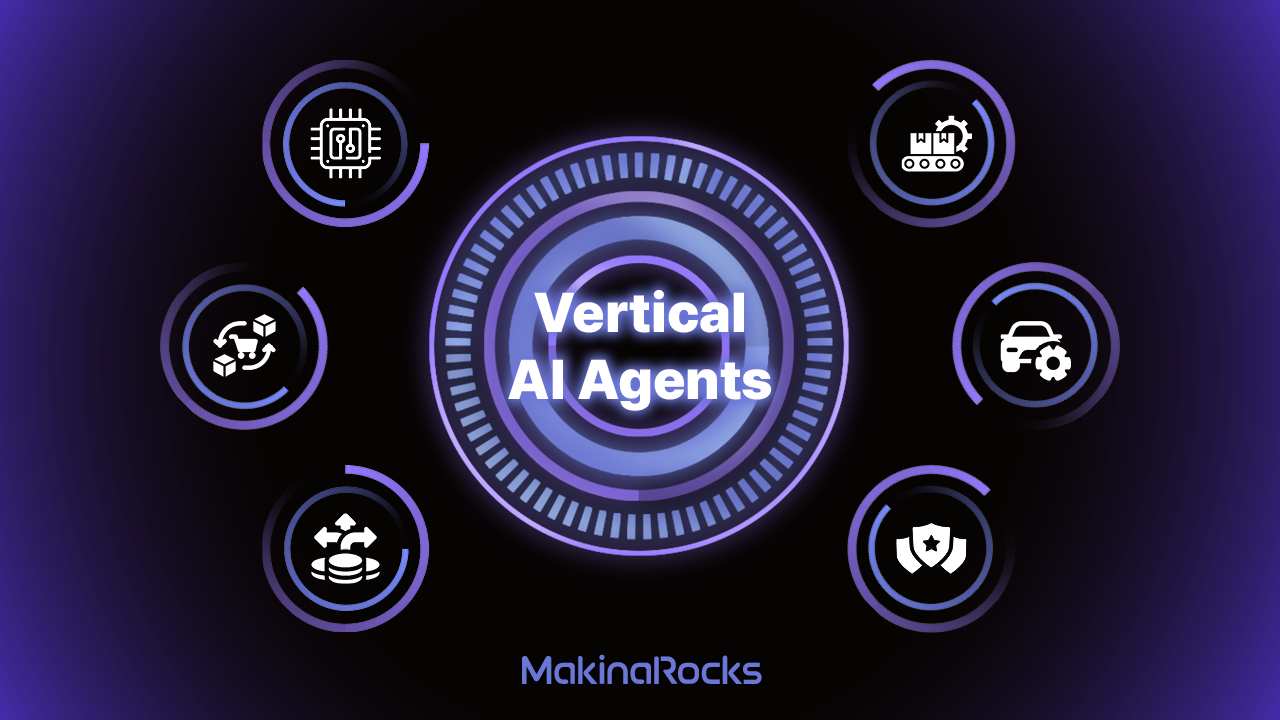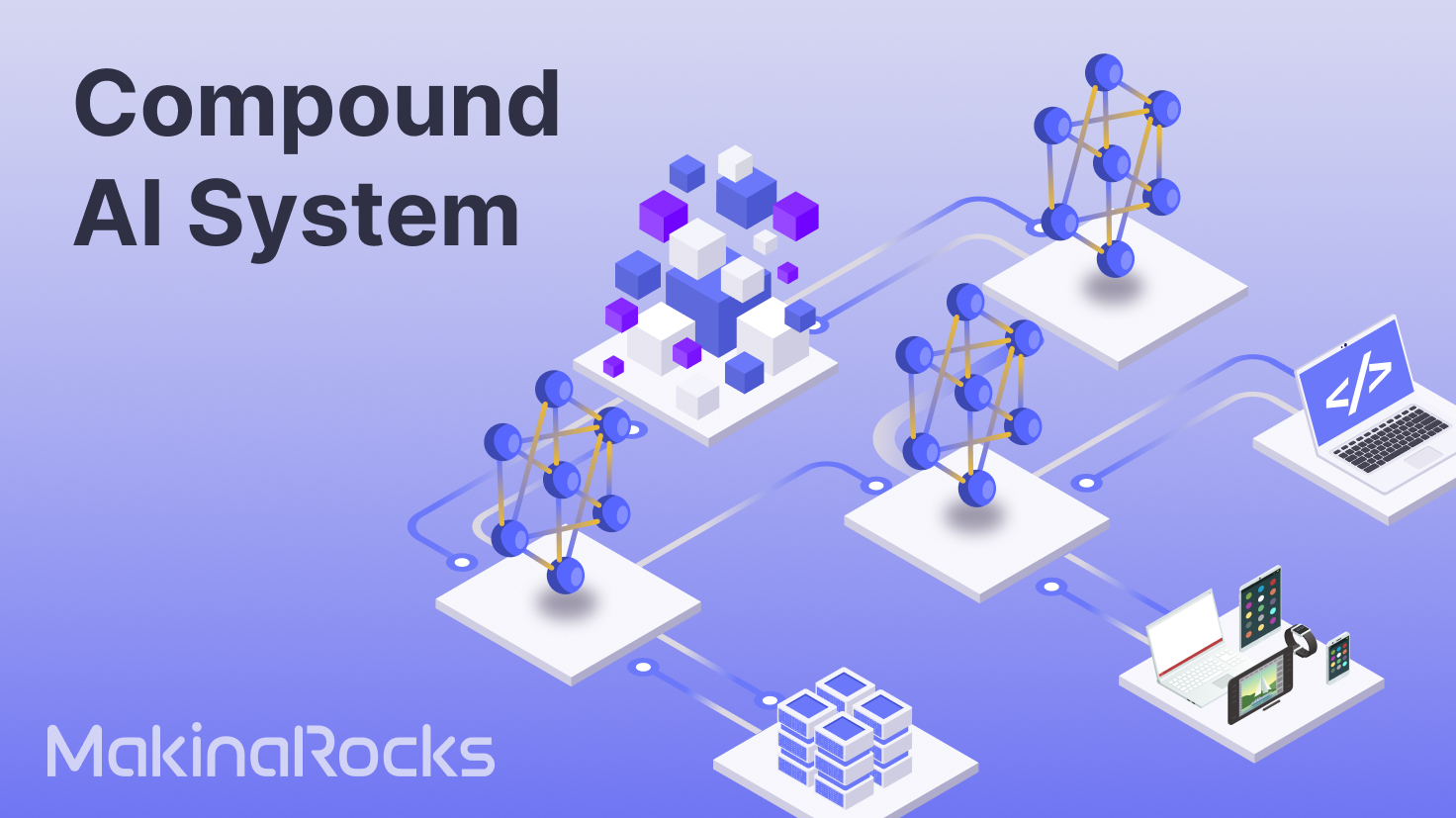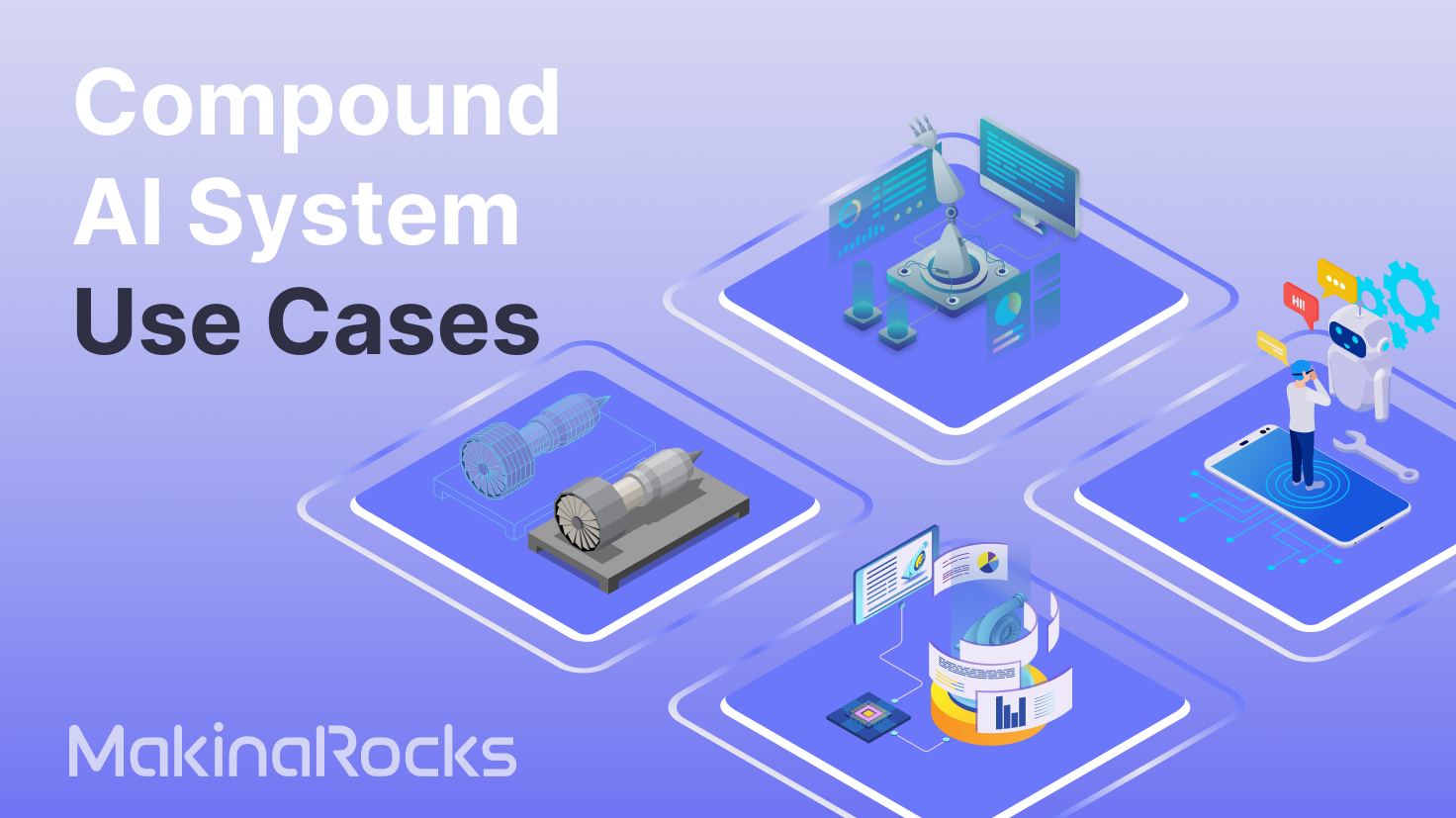Implementing AI agents in industry isn’t just a step forward—it marks a fundamental shift in how automation and intelligence converge. Unlike conventional AI models that passively analyze inputs and return results, AI agents operate autonomously: they plan, make decisions, and execute a series of actions to achieve defined goals. This added complexity demands a more systematic and robust development approach, especially in real-world industrial settings. In particular, vertical AI agents—designed for specific domains—require deep integration with enterprise workflows and a strong understanding of domain-specific AI.
Related contents
- Vertical AI Agents: Built for Industries, Poised to Transform Enterprises
- 5 Ways to Build Agentic System
At MakinaRocks, we develop vertical AI agents to deliver highly customized solutions that align with each industry’s unique needs. For example, by combining API and DB agents, we enable real-time data analysis, defect tracking, and autonomous process control to enhance quality management in manufacturing. So, what does it really take to build AI agents that perform in industrial environments? And how did we bring them to life?
Agent Flow: Solving industry problems step by step

How Makinarocks’ AI agents work in the industrial sector
Since 2017, MakinaRocks has applied AI to solve complex, real-world challenges across industries such as manufacturing, automotive, semiconductors, batteries, chemicals, defense, public, and logistics. Our approach goes beyond collecting customer data—we analyze and structure it in real time to reflect the intricacies of each operational environment. On this foundation, we design AI agents purpose-built to tackle specific problems. These agents are not generic data processors. Each is developed as a modular component with clearly defined roles and responsibilities. For example, an API agent triggers external system actions, a DB agent retrieves data from customer databases via natural language queries, and a retrieval agent references manuals or technical documents to recommend the next course of action—serving as a domain-specific reasoning module.
To coordinate these agents effectively, we implemented a methodology called agent flow. Rather than deploying agents in isolation, agent flow organizes them into a cohesive unit, orchestrated to solve a particular problem from start to finish. For instance, when a spike in defect rates occurs on a production line, the DB agent searches for similar past incidents or relevant manuals, the document processing agent extracts potential solutions, and the API agent initiates the necessary process controls—all while communicating with the user in natural language. What begins as a series of individual actions becomes a unified, intelligent response system.
We implemented agent flow to overcome the limitations we encountered with traditional AI pipelines. Pipelines typically follow rigid, linear steps that may be effective for well-defined tasks but fall short in dynamic industrial environments, where adaptability and contextual understanding are essential. Agent flow addresses this by integrating reasoning, data access, and execution into a single, flexible structure—designed not just to process data, but to solve problems intelligently and autonomously, step by step.
Pipeline vs Agent Flow
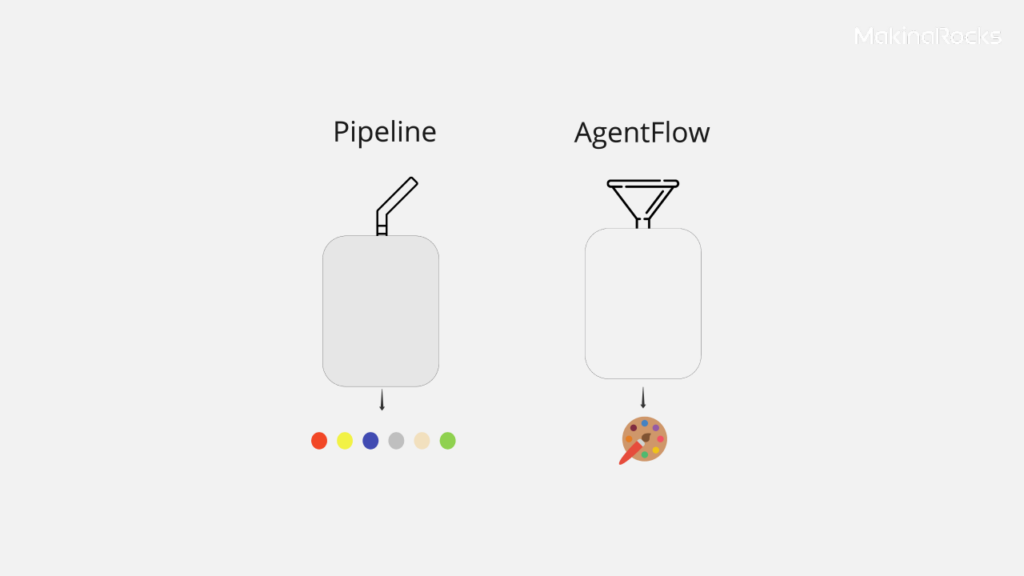
When it comes to building AI-driven systems, pipeline and agent flow offer fundamentally different approaches—especially in how they scale with input types and adapt their responses. Pipelines operate within predefined rules and return fixed outputs, making them reliable but rigid. Agent flow, by contrast, is designed to interpret intent, respond dynamically, and evolve with user interactions—offering greater flexibility in both input handling and response generation.
When it comes to answering questions or handling requests, pipelines rely on fixed processing: a specific input leads to a predefined output. While effective for narrow use cases, this approach becomes increasingly rigid as input types vary—resulting in limited adaptability. Agent flow takes a different path. It analyzes both the user’s intent and the context in real time, dynamically shaping not just the content but also the form of the response. The result is richer, more personalized interactions that go beyond simple data processing—enabling intelligent conversations that evolve with the user.
If your target audience is clearly defined, there are often predictable scenarios. In this case, agent flow excels by ‘bundling’ the right components to handle each situation intelligently, reducing uncertainty and delivering consistent outcomes. But even when your users are more diverse or unpredictable, agent flow still applies. Most user interactions—regardless of the audience—follow recognizable patterns. By identifying and structuring these patterns into repeatable flows, Agent Flow helps automate complex tasks while maintaining flexibility. The result: a scalable system that delivers a consistent, responsive experience to a broad customer base.
Autonomous agent: Handling the unexpected with flexibility
In the real world, it’s common to encounter situations that fall outside predefined scenarios. A new issue may surface after one is resolved, or unexpected user requests and exceptions may arise—none of which were anticipated in the original Agent Flow. These cases are difficult to handle with scenario-based automation alone. That’s where autonomous agents come in.
Autonomous Agents are designed for highly dynamic environments, where uncertainty and change are the norm. Rather than following pre-scripted steps, they learn from data to recognize patterns, detect new problems, and respond accordingly. Once an issue is identified, they formulate a resolution plan on their own—whether that means calling additional APIs, combining multiple data sources, or even generating new data—to achieve the best possible outcome. This flexibility allows them to handle unstructured, open-ended, or previously unseen situations with agility.
At MakinaRocks, we believe that effective problem-solving begins with choosing the right AI agent strategy based on the customer’s needs and the nature of the problem. For clearly defined, repeatable tasks, we leverage agent flow to tightly integrate with customer systems and enable efficient automation. But for edge cases, evolving scenarios, or unexpected needs, we combine agent flow with autonomous agents—creating a hybrid approach that brings together both structure and flexibility.
Vertical AI agent design principles
At MakinaRocks, we prioritize design principles over rigid structures when developing AI agents. Early on, defining the scope of AI agents was not straightforward—we had extensive internal discussions to clarify how these agents should function. Ultimately, we concluded that rather than seeking a single “correct” structure, it was more effective to establish clear design principles first, and then build our AI agents based on those foundations. Guided by the following principles, we’re building an ecosystem in which each AI agent is focused on a specific capability—while remaining modular and flexible enough to adapt to diverse needs and use cases.
- Integrate tools at the agent level
AI agents should be capable of integrating and leveraging various tools—such as APIs, databases, and document repositories—but not all at once. To avoid unnecessary complexity, we modularized these functions into distinct agent types: for instance, an API Agent is responsible solely for API calls and management, while a SQL (DB) Agent translates natural language into real-time SQL queries and retrieves data. This separation of concerns allows each agent to focus on its core responsibility, while enabling greater system flexibility, easier maintenance, and more scalable expansion in the future.
- Standardize data for seamless collaboration
For AI agents to work together effectively, their inputs and outputs must follow a consistent structure. To support this, we adopted the GraphState concept from LangGraph to define a unified data format. This ensures that information produced by one AI agent can be immediately understood and used by others. By standardizing how data flows between agents, we reduce ambiguity in handoffs and allow each agent to stay focused on its own task—without needing to interpret or transform information from others.
- Align autonomous agents with agent flow
Each AI agent should be able to operate both independently and as part of an orchestrated agent flow. That means a single agent can perform a task and pass the results to another, or multiple agents can collaborate to complete a more complex process. This design enables agents to connect organically across workflows and systems—whether acting alone or as part of a multi-agent system—providing flexibility and scalability across use cases.
- Clearly define the role of each AI agent
One key principle is preventing agents from taking on tasks beyond their intended scope. When an AI agent begins to handle responsibilities outside its domain, it increases system complexity, introduces redundancy, and causes confusion during collaboration. For example, if an agent designed to make API calls also processes and summarizes the results, it blurs the lines between roles—making it harder to manage and scale the system. By keeping responsibilities clearly defined, we maintain system clarity, modularity, and overall efficiency.
Agent Factory: Building a next-generation ecosystem for AI agents
At MakinaRocks, we’re focused on more than just designing and delivering industry-specific AI agents. Our vision is to create a system where AI agents can be quickly generated, flexibly combined, and interact organically to solve real-world problems. We call this system the Agent Factory. Inside the Agent Factory, users can rapidly create and deploy various AI agents—placing them in optimal roles to configure new agent flows on demand. By combining orchestration for agent collaboration with seamless integration of external tools (APIs, databases, documents, etc.), the system also supports the development of autonomous agents capable of handling complex, unpredictable environments. Agents built within this system can be easily registered, reused, and managed—enabling scalable, sustainable use across different teams and tasks.
By bringing together the structured process of agent flow and the flexibility of autonomous agents, we’re building a hybrid ecosystem that can dynamically respond to both expected and unexpected scenarios. This approach not only maximizes the utility of AI agents, but also lays the foundation for delivering faster, smarter solutions to customers across industries.
As we grow alongside our customers, MakinaRocks is shaping the standard for vertical AI agents. Questions like “When and how should we use AI agents?” and “What’s the right strategy for each situation?” sit at the core of our technical philosophy—and they continue to drive our commitment to delivering real, impactful AI.
Note: This post was translated from the original Korean version by Kyoungyeon Kim.

